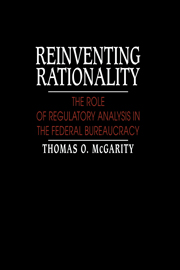Book contents
- Frontmatter
- Contents
- Acknowledgments
- Abbreviations
- Introduction
- Part I The clash of regulatory cultures
- Part II Regulatory analysis in theory and practice
- Part III Structuring regulatory analysis into the decisionmaking process
- 11 Roles for the regulatory analyst
- 12 The hierarchical model
- 13 The outside advisor model
- 14 The team model
- 15 The adversarial model
- 16 A hybrid model
- 17 Selecting the right model
- Part IV Review of regulatory analysis
- Part V Conclusions
- Notes
- Bibliography
- Index
16 - A hybrid model
Published online by Cambridge University Press: 16 October 2009
- Frontmatter
- Contents
- Acknowledgments
- Abbreviations
- Introduction
- Part I The clash of regulatory cultures
- Part II Regulatory analysis in theory and practice
- Part III Structuring regulatory analysis into the decisionmaking process
- 11 Roles for the regulatory analyst
- 12 The hierarchical model
- 13 The outside advisor model
- 14 The team model
- 15 The adversarial model
- 16 A hybrid model
- 17 Selecting the right model
- Part IV Review of regulatory analysis
- Part V Conclusions
- Notes
- Bibliography
- Index
Summary
The Environmental Protection Agency has adopted an intermediate decisionmaking structure that incorporates many of the advantages of both the team and adversarial models and eliminates many of the disadvantages. EPA's Administrator or the Deputy Administrator designates twenty to thirty rules per year for a special “Options Selection-Rejection process.” These rules are reviewed on a quarterly basis by the Deputy Administrator and other upper-level decisionmakers. The lower-level decisionmaking process for these special rules adheres to the team model, except that at crucial junctures an Options Review meeting of very high-level agency officials and team members is held to choose which regulatory options the agency will actively pursue throughout the remainder of the rulemaking process.
EPA's organizational structure
The Environmental Protection Agency (EPA) is responsible for administering eight important environmental statutes and portions of several other laws. EPA regulations can cut across several industries and can have profound impacts on whole sectors of the economy. It is consequently one of the most prolific producers of regulatory analysis documents. The agency is run by an Administrator, a Deputy Administrator, two Associate Administrators, and nine Assistant Administrators, four of whom bear responsibility for implementing the agency's regulatory programs.
The Office of Policy, Planning and Evaluation
The Office of Policy, Planning and Evaluation (the “policy office”) performs a centralized regulatory analysis review function for the agency and manages the agency decisionmaking process to ensure that agency actions remain on schedule and reflect upper-level policy input. Two of its three suboffices–the Office of Policy Analysis and the Office of Standards and Regulations–play a large role in the day-to-day rulemaking process.
- Type
- Chapter
- Information
- Reinventing RationalityThe Role of Regulatory Analysis in the Federal Bureaucracy, pp. 239 - 262Publisher: Cambridge University PressPrint publication year: 1991

